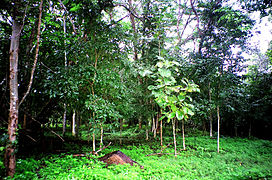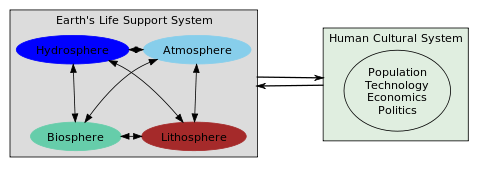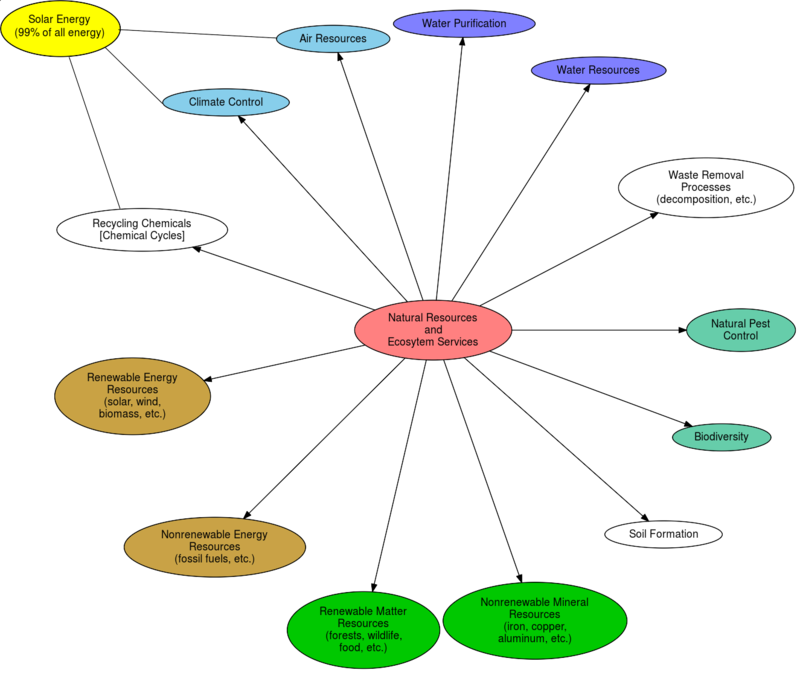What is Environment?
| [▲]Environmental Science | |
|---|---|
| Topics | What is the Environment | Planetary Boundaries | Ecological Footprint and Sustainable Development | Food and Agriculture | Population | Ecology - Definitions and Outline | Energy Flow in Ecosystems | Population and Community Ecology | Material Cycles | Biodiversity | Energy | Atmosphere and Climate | Global Warming | Air Quality | Water Quantity | Water Quality | Solid Waste |
| This introduction defines some basic terms, introduces principles of sustainability, briefly describes environmental ethics, justice, and worldviews. |
Contents
[hide]Introduction and Definitions
Before we can start we must know what we mean by the environment.
- Environment
- Everything that affects a living organism
- Examples: environment is everything affecting us including agriculture and cities
- Environmental Science
- interdisciplinary study of both the scientific and social aspects of the environment and human interactions with the environment.
Notice the use of the word "interdisciplinary". Environmental science includes chemistry, physics, biology, geology, engineering, etc. It also includes not only science, but social sciences such as economics, politics, geography, etc. It also includes how humans interact with the environment.
The definition of environmental science should be compared with that for ecology:
- Ecology
- branch of biology studying relationship between living organisms and their environment.
Finally a definition we will use below. Note this is a working definition. A more precise definition will be given later (see the ecology section):
- Ecosystem
- A region within which organisms interact. For example: the Amazon, Khao Yai National Park.
Systems approach
The environment can be considered to be divided into systems.
Environmental science is then how these systems interact with each other.
Systems involved are:
- Biosphere - all living organisms
- Lithosphere - the Earth's solid surface (rock, soil, etc.)
- Hydrosphere - Water in all its forms: liquid, solid (ice), vapor
- Atmosphere - the air surrounding the Earth
These four systems can together be called the Earth's Life Support System. But since we are also wanting to consider how humans react to the environment, we need to add the human cultural system. This includes politics, economics, social interactions, and technology. The diagram shows how these are all related.
Sustainability
- Sustainability
- Ability of the Earth's natural systems and human cultural systems to survive and adapt to changing environmental conditions into the future
Principles of Sustainability
There are six principles to achieving sustainability, three are based on science and three are based on social sciences.
Science Principles
- Dependence on solar energy (ultimate energy source for almost all organisms) [note 1]
- Biodiversity (ecosystem services provided by various species)
- Chemical cycling (chemicals, such as nutrients, are continually being recycled through the ecosystem)
Social Science Principles
- Full-cost pricing (including costs in addition to benefits)
- Win-win solutions (as opposed to a win-lose approach) - concept comes from game theory
- Responsibility to future generations (see sustainable development)
Natural Capital
Another way to look at the importance of the environment the concept of natural capital as shown in the diagram below:
Environmental Ethics and Worldviews
Environmental Ethics
- Ethics
- A set of moral values (what is right or wrong)
- Environmental Ethics
- Extension of ethics to include not only humans, but all the environment
Examples
Humans are members of a community of life along with all other species, and on equal terms
---
When we try to pick out anything by itself, we find it hitched to everything else in the universe
---
The Earth system behaves as a single, self-regulating system with physical, chemical, biological, and human components
Declaration of Amsterdam (on the Gaia hypothesis)
Environmental Worldviews
- Environmental Worldviews
- Set of assumptions and values reflecting how you think the world works and what your role in the world should be.
There are many ways to look at the environment. These worldviews can be divided as follows:
- Human-centered (Anthropocentric) - Nature is primarily a support system for humans. Animal, plants, and the Earth are for the use of man.
- Life-centered (Biocentric)- all living organisms (including humans) have equal value.
- Earth-centered - Earth's life-support systems exist for all species for billions of years, long before humans existed.
Environmental Approaches
Environmental approaches, are how we approach the issues of economic development and preserving nature.
- Development - The development approach considers the most important factor to be economic development. This economic development is more important then preserving nature.
- Preservation - The preservation approach is to preserve as much of the environment as possible. Nature has intrinsic value independent from human use.
- Conservation - This attempts a balance between the development and preservation approaches. A good example of this is preservation of natural areas for use as hunting or fishing areas.
Environmental Justice
- Environmental Justice
- promotes environmental, economic and social justice by recognizing the direct link between economic, environmental and health issues and demanding a safe, clean community and workplace environment.
Environmental justice is designed to prevent Environmental Discrimination
Environmental Discrimination -- Examples
In the United States, African-Americans and Hispanics are more like to live near a polluting industry and are more likely to be exposed to pollution. (Environmental racism) [1]
In Brazil (and other countries) indigenous people's land is being illegally logged and occupied by agribusiness.
In Indonesia, some rich upper class people are using their wealth to influence local governments to allow plantations, etc. to take over forests.
In Papua New Guinea, mining companies from (mostly) Australia are polluting the environment. These rich country companies are using weak environmental regulations to increase profits. (Environmental imperialism)
Notes
- Jump up ↑ Note here we refer to energy from the sun, not solar energy for power
References
- Jump up ↑ Clark LP, Millet DB, Marshall JD (2014) National Patterns in Environmental Injustice and Inequality: Outdoor NO2 Air Pollution in the United States. PLoS ONE 9(4): e94431. https://doi.org/10.1371/journal.pone.0094431





